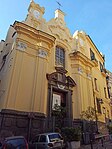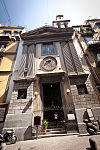Santa Caterina da Siena, Naples
17th-century Roman Catholic church buildings in ItalyBaroque architecture in NaplesFormer churches in NaplesItalian church stubs

The church of Santa Caterina da Siena is located in the city center of Naples, Italy, and while built in the 16th century, the interior was decorated by Baroque era artists over the next two centuries.
Excerpt from the Wikipedia article Santa Caterina da Siena, Naples (License: CC BY-SA 3.0, Authors, Images).Santa Caterina da Siena, Naples
Gradini Santa Caterina da Siena, Naples San Ferdinando
Geographical coordinates (GPS) Address External links Nearby Places Show on map
Geographical coordinates (GPS)
| Latitude | Longitude |
|---|---|
| N 40.83915 ° | E 14.242866 ° |
Address
Chiesa di Santa Caterina da Siena
Gradini Santa Caterina da Siena
80132 Naples, San Ferdinando
Campania, Italy
Open on Google Maps











